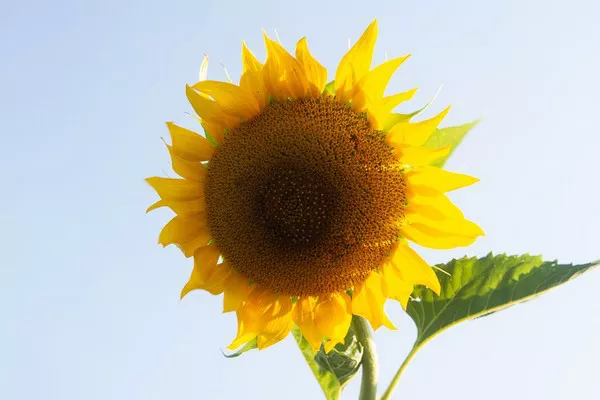Sunflowers, with their bright and cheerful blooms, are a popular choice for gardeners looking to add a burst of color to their outdoor spaces. While many people associate sunflowers with large fields or garden beds, they can also thrive when planted in pots. Whether you have limited space or simply want to enjoy the beauty of sunflowers up close, this guide will walk you through the steps to successfully plant and care for sunflowers in a pot.
1. Selecting the Right Pot
Choosing the Ideal Container
Selecting the right pot is a critical first step in planting sunflowers. Sunflowers have deep roots, so opt for a pot that is at least 12 inches in diameter and 12 to 18 inches deep. This depth allows the roots to grow comfortably and ensures stability for your sunflower plant as it grows tall.
Materials Matter
Choose a pot made of durable materials, such as clay or plastic. Ensure that the pot has drainage holes at the bottom to prevent water from pooling and causing root rot.
2. Choosing Sunflower Varieties for Pots
When planting sunflowers in a pot, it’s best to select compact varieties. Dwarf sunflowers like the “Sunflower Dwarf Sunspot” or “Teddy Bear” are ideal choices. These sunflowers grow to a manageable height of around 12 to 24 inches, making them suitable for container gardening.
3. Soil Preparation
Select Quality Potting Mix
Sunflowers require well-draining soil for optimal growth. Choose a high-quality potting mix designed for flowers or vegetables. Avoid using garden soil, as it can become compacted in containers and hinder root development.
Enhance Drainage
To further improve drainage, you can add perlite or coarse sand to the potting mix. This helps prevent waterlogged soil, which can lead to root diseases.
4. Planting Sunflower Seeds
Sowing Sunflower Seeds
Plant sunflower seeds directly into the pot after the last frost date for your region. Sow the seeds about 1 inch deep and space them 6 to 12 inches apart, depending on the variety. Make sure to follow the planting instructions on the seed packet for your specific sunflower variety.
Sunlight Requirements
Sunflowers thrive in full sun, so place your pot in a location that receives at least 6 to 8 hours of direct sunlight daily. If you’re growing sunflowers indoors, use a south-facing window or provide supplemental lighting with grow lights.
5. Watering and Maintenance
Consistent Watering
Keep the soil consistently moist but not waterlogged. Water your potted sunflowers when the top inch of soil feels dry to the touch. Be mindful of overwatering, as it can lead to root rot.
Fertilizing
Sunflowers benefit from a balanced, all-purpose liquid fertilizer. Apply fertilizer every 2 to 3 weeks during the growing season, following the manufacturer’s instructions for dilution and application.
Supporting Tall Varieties
If you’re growing taller sunflower varieties in pots, consider staking or providing support to prevent them from toppling over as they grow. A bamboo stake or a small trellis can help keep your sunflowers upright.
6. Dealing with Pests and Diseases
Common Pests
Keep an eye out for common garden pests such as aphids, snails, and slugs. If you notice any infestations, treat your sunflowers promptly with appropriate organic pest control methods or insecticidal soap.
Preventing Diseases
To prevent fungal diseases, avoid overhead watering, as wet leaves can encourage issues like powdery mildew. Water at the base of the plant instead.
7. Pruning and Deadheading
Deadheading
Remove spent flowers by deadheading regularly. This encourages your sunflower to produce more blooms and prolongs the flowering period.
Pruning
While sunflowers generally don’t require extensive pruning, you can trim back any yellowing or damaged leaves to promote overall plant health.
8. Harvesting Sunflower Seeds
Seed Development
Once your sunflowers have finished blooming, the seeds will begin to mature. The back of the flower head will turn brown, and the seeds will start to loosen.
Harvesting
To harvest sunflower seeds, cut the flower head from the stem when the back turns brown but before the seeds begin to fall out. Hang the flower head upside down in a dry, well-ventilated area to finish drying.
Extracting Seeds
Once the flower head is dry, you can easily extract the seeds by rubbing them off with your hand or a fork. Store the seeds in a cool, dry place in an airtight container.
Conclusion
Planting sunflowers in a pot can be a rewarding gardening experience, allowing you to enjoy these vibrant blooms up close. By selecting the right pot, providing the appropriate care, and choosing the best sunflower varieties for containers, you can successfully cultivate sunflowers in a limited space. With proper maintenance and a little patience, you’ll be rewarded with the cheerful sight of sunflowers gracing your patio, balcony, or any other small gardening space.


